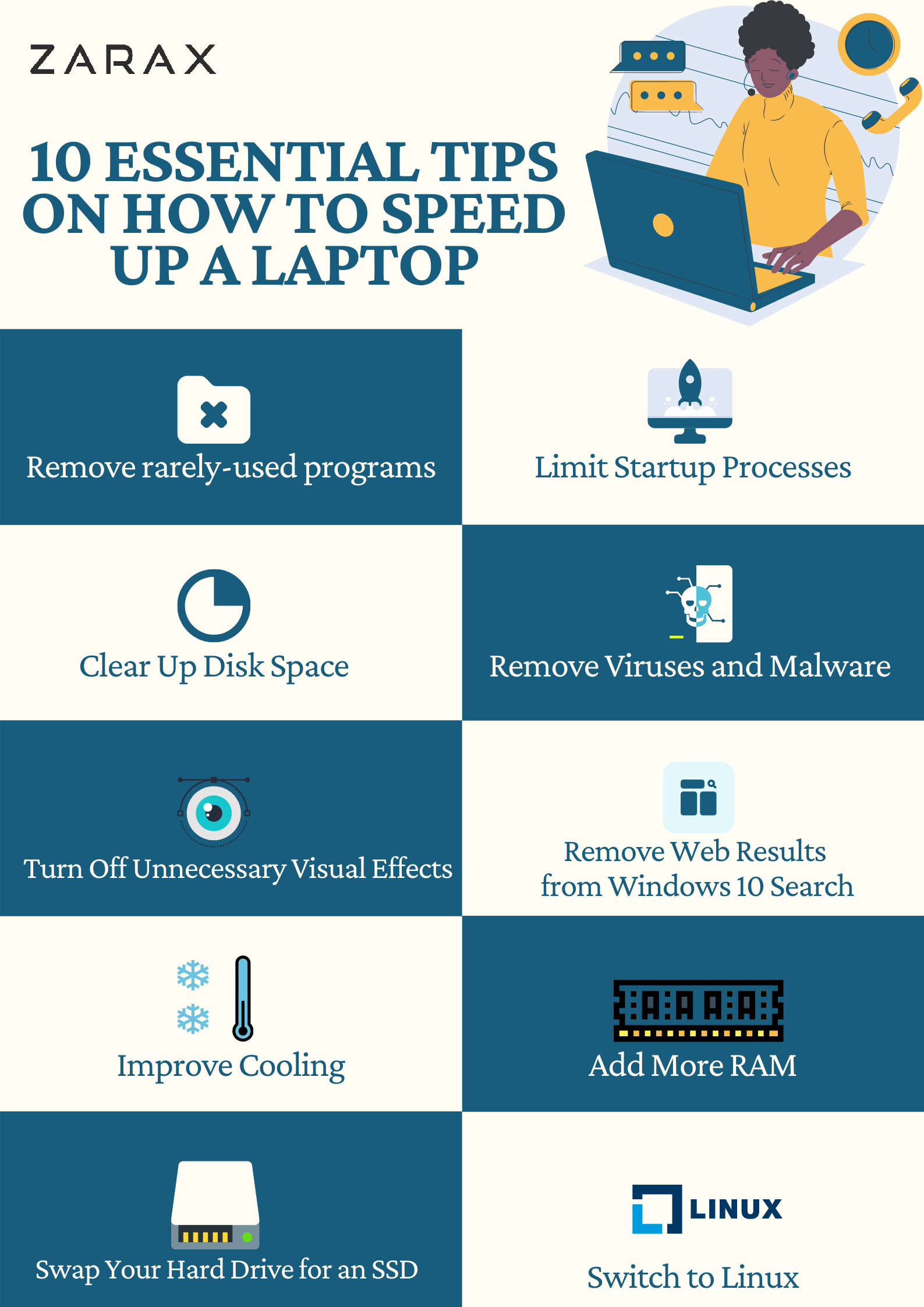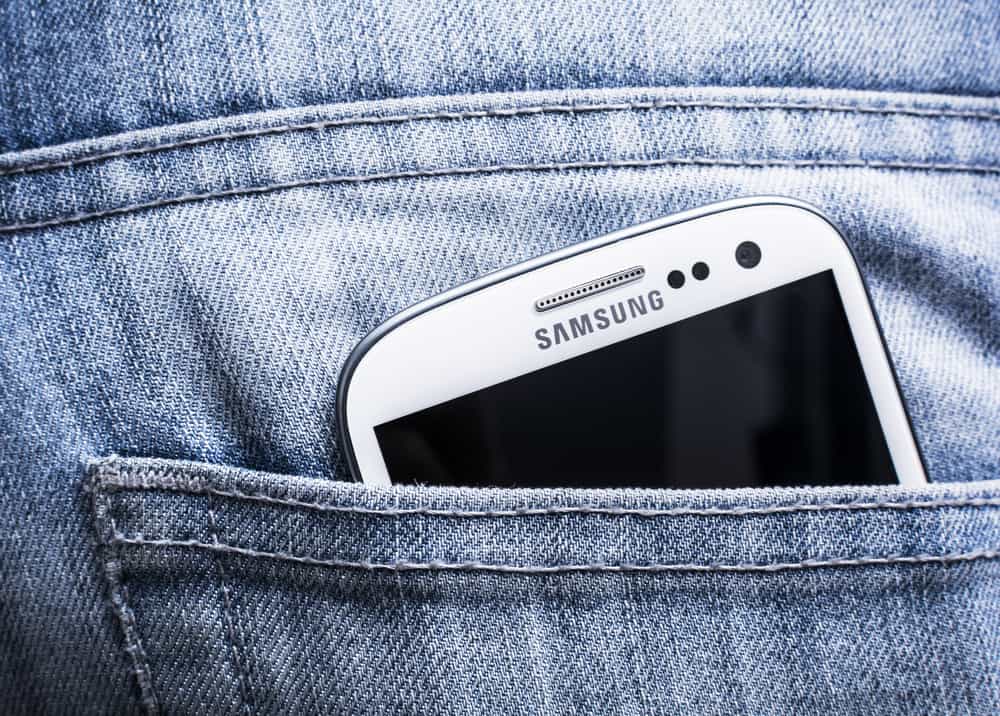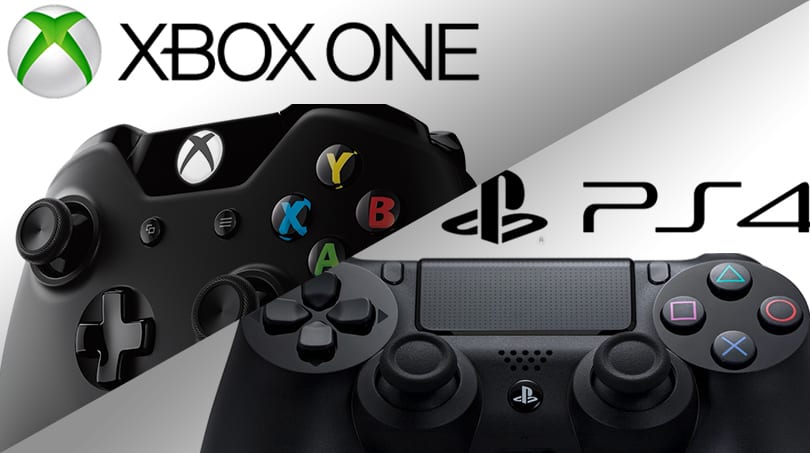Why Is My Computer So Slow?
After years of using your laptop for work, school, or gaming, you may start to notice it starting to get sluggish. It can range from just mildly annoying to virtually unusable. You may then think of buying a new laptop, but you don’t have the budget for it.
Don’t worry as it shouldn’t be too hard to freshen it up. While it may be a few years old or a tad bit underpowered, you can still make it usable for general tasks like web browsing, media consumption, office work, and video conferencing.
All you need is to know what may slow it down in the first place. You may have to declutter it or even get some simple upgrades to extend its usefulness for at least a few more years.
So, here are the top 10 tips that will teach you how to make your laptop faster in no time.
1. Remove Bloatware and Rarely-Used Programs
Whether your laptop is old or new, it can get bogged down by excess applications running in the background. Laptops tend to come with bloatware pre-installed by their manufacturers, either proprietary software or third-party applications due to commercial distribution deals between them and software companies.
Your laptop can also be clogged up by programs you previously installed that you rarely use. They occupy crucial drive space, which may make your laptop run less optimally. The first step towards speeding up your laptop is to uninstall these programs to clean up the clutter.
2. Limit Startup Processes
Many applications are meant to start with Windows automatically. They then usually run in the background, sometimes having an icon in the system tray. That takes up precious system resources, which can then bog down your system. Also, having them open automatically makes Windows startup slower.
Therefore, you only want to have programs you absolutely need to start with Windows. A simple way to remove or disable these programs is to open Task Manager, which you can do by right-clicking on the Start button in Windows 10 and clicking on it. You then select the Startup tab. This shows the list of programs that start with Windows.
Right click on the programs you want to remove from startup and disable them. Another convenient feature with this feature on Task Manager is that it also tells you how much impact each program has on Windows startup, so you can decide on disabling those that have high impact. You can then choose to open those programs manually when you need them.
3. Clear Up Disk Space
Perhaps your storage is still clogged up with photos, audio files, videos, and so on. Drives, whether they’re mechanical hard drives or solid-state drives, tend to slow down when they’re close to being filled up. It’s best to keep clutter out of your system drive.
As a general rule-of-thumb, you want to have at least more than 10% free space on your system drive to keep things from slowing down. For solid-state drives, you want to have at least 25% free space to maintain optimal read and write performance.
Use the Disk Cleanup utility to delete temporary files, thumbnails, system logs, and other unneeded files. You can also delete your web browser’s cache to free up even more space and speed up your web browser.
If you have tons of images, videos, and other files you want to keep, you may want to put all of that in a separate drive. That will help keep your system drive running smoothly.
4. Remove Viruses and Malware
If you’re not running any anti-virus and/or anti-malware software, you’ll find your laptop being infected by viruses and malware from the modern internet. While most of these malicious scripts and applications tend to be fairly harmless, they can pile up and clog up your system.
Either some of them are really bad or you get a lot of them on your laptop, it will certainly make your system unusable sooner or later. They can also leak data and create backdoors to your system that makes you vulnerable. Whether you care about your own security or not, there are more than enough reasons to remove them and keep them from coming back.
Windows 10 tends to come with Windows Security, formerly known as Windows Defender, which is adequate for most users. If you’re more of a power user, you may want to get a different anti-virus program like Kastersky, BitDefender, ESET, TrendMicro, Panda Security, Sophos, or so on. Don’t get Avast, Avira, or AVG—they install excess baggage you don’t need.
As for anti-malware software, Malwarebytes is widely accepted as one of the best. For removing other malicious stuff from your system like adware, spyware, and so on, you can also run Adwcleaner, rKill, and RogueKiller every now and then.
5. Turn Off Unnecessary Animations and Visual Effects
Since Windows XP and Vista, Microsoft has added a lot of visual polish to make the operating system look good. However, these animations and visual effects tend to slow things down, especially in older laptops. While Windows 10 does tend to automatically disable some of them based on your system specifications, you may want to just turn them all off.
Open the Start Menu and type ‘Adjust the appearance and performance of Windows’ to open the Performance Options window. In the Visual Effects tab, you can uncheck all the boxes to turn off all the animations and visual effects. This should make Windows 10 run a bit snappier.
6. Remove Web Results from Windows 10 Search
Search indexing in Windows 10 has gotten better over the years compared to previous versions of Windows. However, aside from searching files in your system, it also tends to bring up web search results. If you don’t tend to use those results from Windows 10 search for your web browsing needs, you can turn this built-in feature off to help speed things up.
Search for Group Policy Editor, or you may also type gpedit.msc on either search or run window. You should then go to Local Computer Policy > Computer Configuration > Administrative Templates > Windows Components > Search, then look for ‘Do not allow web search’, ‘Don’t search the web or display web results in Search’ and ‘Don’t search the web or display web results in Search over metered connections’.
Enable all of them. That should turn off web results from Windows 10 search to free up some system resources and speed up your future searches.
7. Improve Cooling
If your CPU goes up to 80 degrees Celsius or over, there’s a big chance that it will do something called thermal throttling. It will deliberately slow itself down so it doesn’t get any hotter. If it reaches 100 degrees Celsius for a minute or so, the laptop will automatically shut itself off.
To avoid thermal throttling, you’ll have to make sure the system can cool itself properly. Make sure you don’t block the vents while the laptop is on so air can flow out. You may also use an external cooling pad that sits underneath and blasts cool air into the underside of your laptop to help it stay cool.
If it still doesn’t stay at safe temperatures, you may have to open up the laptop to replace the thermal paste. Every laptop is different, so you’ll have to learn how yours can be opened up. You may find a video online on how to disassemble it safely, wipe off the old thermal paste with a rag and some rubbing alcohol, apply new thermal paste, and put everything back together.
Most people won’t be either knowledgeable or confident enough to disassemble their own laptop. A service center may do this for you, and they may even have other cooling solutions available for your laptop. This will incur extra expenses, but better cooling will help extend the lifespan of your laptop.
8. Add More RAM
Many of the previous tips are about freeing up system resources to make things run smoother. However, they won’t do much good if you only have 4GB of memory or less. Many commonly-used applications tend to be memory hogs, such as modern web browsers.
If you’re using the 32-bit version of Windows, you may want to switch to the 64-bit version since the 32-bit can’t use more than 4GB of memory. If you’re able to get to at least 8GB of memory, you’ll notice that things run more smoothly. Web browsing will certainly be less sluggish.
Hopefully, your laptop memory is expandable. If your laptop has its memory soldered to the motherboard, then you’re out of luck.
9. Swap Your Hard Drive to an SSD
Swapping to a solid-state drive is perhaps the best advice for making an old laptop snappier. Having an SSD as your system drive can immediately make startup and program loading times a whole lot faster. A mechanical hard drive has to spin in order to read and write data, while an SSD has no moving parts.
The price-to-capacity ratio with SSDs has become a lot better over the years. You can now get a 512GB or 1TB SSD for a really good price these days. Along with upgrading your ram, you can turn back the clock on your laptop with just these two hardware upgrades.
10. Switch to Linux
This is perhaps the most intimidating tip on this list, so you may only look into this if all other options have failed to make your aging laptop usable again.
Windows 10 can feel like a bloated beast of an operating system, which is why some people prefer using Linux. However, Linux comes in a huge variety of different distributions, or distros, that may be confusing for beginners.
Each distro is designed to be good for specific types of users. For instance, Ubuntu or Linux Mint can be great for beginners who are more used to Windows or MacOS, while more advanced ones like Gentoo or Arch Linux are for those who really know what they’re doing.
Switching to Linux isn’t the easiest thing to do, but you can end up with an operating system that runs a lot faster, has little to no bloat, and is good for most tasks like web browsing, office work, and even gaming. While it can get really fiddly with maintenance and troubleshooting, you may end up liking it more.
Conclusion
Knowing how to tweak and maintain a laptop in optimal conditions can save you a lot of time and money down the line. After all, after using it for a good while, you become familiar with your laptop’s particular quirks and features. Even if you buy a new laptop, it’s not the same laptop that has long become your daily driver.
If you did all of this and your laptop is still super slow, then it may really be time for you to buy a new laptop. Computers deteriorate over time and are not built to last forever. When their performance degrades to the point of impracticality, no matter how much you tweak and declutter, then it really is time for a new machine.
That should be easy enough to replace if you do have the cash for it. But if you’re strapped, you should go for a laptop that’s designed for the very purpose you need it. There’s no sense in buying an ultra-expensive gaming laptop or mobile workstation if you’re only using it for office work and video conferencing.
Failing all that, if you haven’t found ways to speed up your laptop even after following all of our suggested steps, the best thing to do may be to swap it out for a new one. It may be worth looking into selling your old laptop, which will allow you to save money and get a head start on saving up for a brand new laptop.













